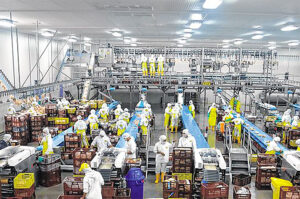You might think I had made my way to Florida’s infamous tomato fields, or somewhere in the depths of the California’s migrant-dependent Central Valley. Those places remain obscure to most Americans, but the gross human exploitation they represent has at least been documented in a spate of excellent recent books, like Barry Estabrook’s Tomatoland, Tracy McMillan’s The American Way of Eating, and Seth Holmes Fresh Fruit, Broken Bodies. But I was somewhere yet more remote and less well-known: Sinaloa, a largely rural state in Mexico’s northwestern hinterland.
If most Americans have heard of Sinaloa at all, it’s because of the state’s well-earned reputation as a center of Mexico’s bloody drug trade. But in addition to the eponymous drug cartel, Sinaloa also houses vast-scale, export-oriented agriculture: farms that churn out the tomatoes, melons, peppers, and other fresh produce that help fill US supermarket shelves. And the people who do the planting, tending, and harvesting tend to be from the indigenous regions of Mexico’s southern states, Oaxaca and Chiapas, where smallholder farming has been ground down by decades of free-trade policies pursued by the Mexican government, which left millions in search of gainful work to the north.
In my brief time there, I found Sinaloa overwhelming: a scary cauldron of labor exploitation, industrial agriculture, and drug violence. Now, Los Angeles Times reporter Richard Marosi and photographer Don Bartletti have documented the grim conditions faced by workers on Mexico’s export-focused megafarms in a long-form investigation, after 18 months of reporting in nine Mexican states, including, most prominently, Sinaloa. The Times plans to publish it in four parts; the first, here, is stunning.
Marosi found that Mexico’s megafarms adhere to the strictest standards when it comes to food safety and cleanliness, driven by the demands of big US buyers. «In immaculate greenhouses, laborers are ordered to use hand sanitizers and schooled in how to pamper the produce,» Marosi writes. «They’re required to keep their fingernails carefully trimmed so the fruit will arrive unblemished in US supermarkets.»
While the produce is coddled, the workers face a different reality. Pay languishes at the equivalent of $8 to $12 a day. Marosi summarizes conditions that often approach slavery:
- Many farm laborers are essentially trapped for months at a time in rat-infested camps, often without beds and sometimes without functioning toilets or a reliable water supply.
- Some camp bosses illegally withhold wages to prevent workers from leaving during peak harvest periods.
- Laborers often go deep in debt paying inflated prices for necessities at company stores. Some are reduced to scavenging for food when their credit is cut off. It’s common for laborers to head home penniless at the end of a harvest.
- Those who seek to escape their debts and miserable living conditions have to contend with guards, barbed-wire fences, and sometimes threats of violence from camp supervisors.
- Major US companies have done little to enforce social responsibility guidelines that call for basic worker protections such as clean housing and fair pay practices.




